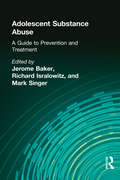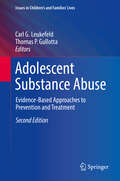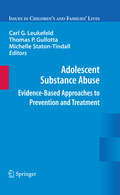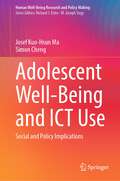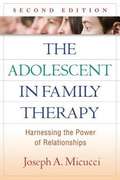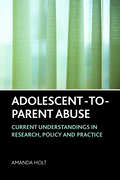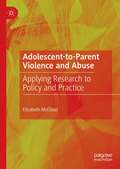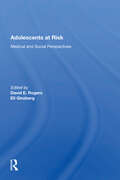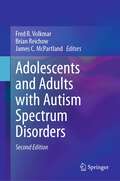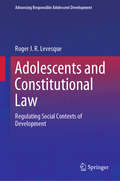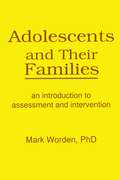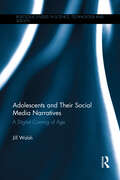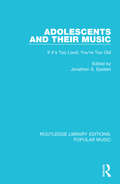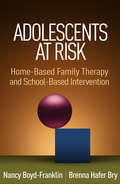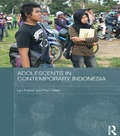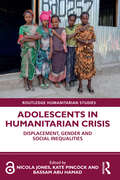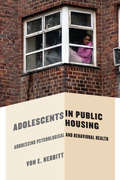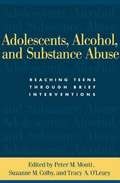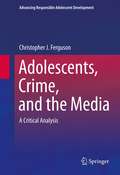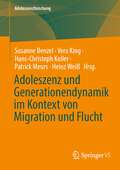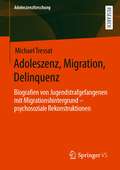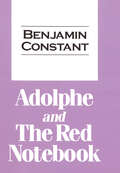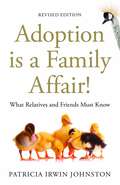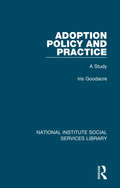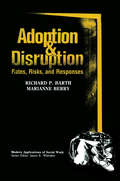- Table View
- List View
Adolescent Substance Abuse: A Guide to Prevention and Treatment
by Richard Isralowitz Mark Singer Jerome BekerAn enlightening discussion of the major issues related to the prevention and treatment of adolescent substance abuse. Information-packed chapters lend a new perspective to the field and suggest implications for practice in services for youth.
Adolescent Substance Abuse: Evidence-Based Approaches to Prevention and Treatment (Issues in Children's and Families' Lives #9)
by Thomas P. Gullotta Carl G. LeukefeldThe second edition of this book incorporates the latest theory, research, and best practices for understanding, treating, and preventing substance abuse among adolescents. It updates the progress made in treatments for and prevention of the misuse of substances and adds new specific chapters on prescriptions, opiates, and methamphetamine abuse. The book discusses the effects of commonly abused substances, from tobacco and alcohol to stimulants and opioids, on the human brain and the various psychosocial routes to their misuse by adolescents. Chapters provide evidence-based guidelines for assessing adolescent treatment needs and review psychological, pharmacological, family, and self-help interventions. The book offers new paths in diverse directions, analyzes the core components of substance use prevention, critiques emerging school-based interventions, and introduces a nuanced reconceptualization of recovery.Topics featured in the book include:The effect of family and caregiver situations on adolescent substance abuse.A biological/genetic perspective on adolescent substance abuse.School-based preventions and the evolution of evidence-based strategies.The role of adolescent self-help in substance abuse interventions.Community-based interventions to reduce alcohol use and misuse. Adolescent Substance Abuse, Second Edition, is a must-have reference for researchers, clinicians/practitioners, and graduate students in the fields of child and school psychology, social work, public health, developmental psychology, child and adolescent psychiatry, and various interrelated mental health and social policy arenas.
Adolescent Substance Abuse: Evidence-Based Approaches to Prevention and Treatment (Issues in Children's and Families' Lives #9)
by Michelle Staton-Tindall Thomas P. Gullotta Carl LeukefeldSubstance abuse is, and has always been, an indisputable fact of life. People - especially young people - abuse various legal and illegal substances for any number of reasons: to intensify feelings, to achieve deeper consciousness, to escape reality, to self-medicate. And as substance-abusing teenagers mature, they pose particular challenges to the professionals charged with keeping them clean and sober and helping them maintain recovery into adulthood. Adolescent Substance Abuse: Evidence-Based Approaches to Prevention and Treatment offers clear, interdisciplinary guidance that grounds readers in the many contexts - developmental, genetic, social, and familial among them - crucial to creating effective interventions and prevention methods. Its contributors examine current findings regarding popularly used therapies, including psychopharmacology, residential treatment, school- and community-based programs, group homes, and specific forms of individual, family, and group therapy. Accessible to a wide professional audience, this volume: (1) Presents evidence-based support for the treatment decision-making process by identifying interventions that work, might work, and don't work. (2) Identifies individual traits associated with susceptibility to substance abuse and addiction in youth. (3) Provides a biogenetic model of the effects of drugs on the brain (and refines the concept of gateway drugs). (4) Evaluates the effectiveness of prevention programs in school and community settings. (5) Adds historical, spiritual, and legal perspectives on substance use and misuse. (6) Includes the bonus resource, the Community Prevention Handbook on Adolescent Substance Abuse and Treatment. This volume is an all-in-one reference for counseling professionals and clinicians working with youth and families as well as program developers in state and local agencies and graduate students in counseling and prevention.
Adolescent Well-Being and ICT Use: Social and Policy Implications (Human Well-Being Research and Policy Making)
by Simon Cheng Josef Kuo-Hsun MaIn this book, the authors expertly examine the issue of adolescent well-being in the light of their exposure to and use of information and communication technologies (ICTs) at school and home. The authors discuss a new form of inequality especially noticeable among youth, which is, digital inequality/divide, created through rapid developments in ICT. They analyze the relation between digital divide and educational inequality among youth, describe patterns of social exclusion from technology and education, and discuss related policies in industrialized nations to see how well-being issues can be addressed in this context. Comparing results based on nationally representative and internationally comparative datasets across 28 countries, the authors ask how and why the benefits accruing from ICT are substantially greater for some adolescents, but apparently smaller for others and how such differences may be reduced. They provide policy suggestions that are broadly based in the fields of well-being, secondary education, and technology use. This book is of interest to researchers and students of quality of life and well-being studies and a wide range of social science and education disciplines, including the sociology of education, media sociology, sociology of childhood and adolescence, communication studies, and science and technology education.
Adolescent in Family Therapy, Second Edition
by Joseph Micucci Celia FalicovRich with clinical wisdom, this successful text and practitioner guide offers a comprehensive framework for treating adolescent problems in the family context. Even as teenagers become increasingly independent, Joseph Micucci shows, they still need parental guidance and nurturance. By strengthening family relationships, clinicians can alleviate symptoms and promote behavioral change. Vivid examples and session transcripts illustrate specific strategies for treating eating disorders, depression, anxiety, defiance, underachievement, and other frequently encountered challenges. Weaving together family therapy techniques with ideas from psychodynamic and cognitive-behavioral approaches, the book has a pragmatic focus on effective interventions for getting adolescent development back on track. New to This Edition Thoroughly updated to reflect current research and reader feedback. Chapter on adolescent anxiety disorders. Expanded coverage of attachment issues; lesbian, gay, and bisexual youth; and racial and ethnic identity. New case material, one of the book's most popular features.
Adolescent-to-Parent Abuse: Current Understandings in Research, Policy and Practice
by Amanda HoltWhile much has been written about the problematic behaviour of young people and their families, there has been silence on the problem of young people behaving abusively towards their parents, which may take the form of physical, economic and/or emotional abuse. This is the first academic book to focus on adolescent-to-parent abuse and brings together international research and practice literature and combines it with original research to identify and critique current understandings in research, policy and practice. It discusses what we know about parents' experiences of adolescent-to-parent abuse and critically examines how it has been explained from psychological, sociological and sociocultural perspectives. It also outlines how policymakers and practitioners can usefully respond to the problem. This unique book adopts a range of theoretical and practice perspectives. Written in an accessible style, it is an essential tool for academics, policymakers and professionals with an interest in domestic violence, child protection and youth offending.
Adolescent-to-Parent Violence and Abuse: Applying Research to Policy and Practice
by Elizabeth McCloudThis book seeks to break new ground in the way in which adolescent-to-parent violence and abuse is understood. Incorporating knowledge from an original research project undertaken in the UK and international literature, this book provides insight into the prevalence of this form of domestic violence which can include psychological, physical, and economic abuse. Young person and family characteristics are explored, and links are made between sibling aggression and school bullying behaviours. A key theme is how the data can be used to develop statistical models which can screen for young people behaving abusively towards their parents. It discusses how the research can be applied to inform theoretical frameworks, policy development, and professional practice, with a focus on prevention and early intervention that uses positive youth justice and restorative approaches.
Adolescents At Risk: Medical and Social Perspectives
by David E. RogersThis text seeks to examine the factors that cause teenage violence, risky sexual behaviour (including risk of AIDS), and alcohol and drug abuse. It also addresses the guidelines that should be followed by those who seek to reduce societal costs resulting from the disfunctional behaviour of young people unable to make the transition from adolescence to young adulthood without special assistance and support.
Adolescents and Adults with Autism Spectrum Disorders
by Fred R. Volkmar Brian Reichow James C. McPartlandThe second edition of this book examines the numerous research and practice advances with regard to adolescents and adults with autism spectrum disorders (ASD). Expert contributors offer cogent reviews of complex issues, from education to employment, leisure activities to illegal behaviors, mental health issues to medical health concerns. The volume explores the latest findings in key areas, such as psychosocial and residential treatments, social skills programs, epidemiology, the impact of ASD on families. The book focuses on areas of research and practice that require improved models of assessment, current data, new interventions, and increased support services. Key areas of coverage include: Transition from high school to adulthood for adolescents and young adults with ASD. Innovative programming to support college students with ASD. Romantic relationships, sexuality and ASD. Treatment of mental health comorbidities. Assessment and treatment planning in adults with ASD. The range of outcomes and challenges in middle and later life for individuals with autism. The second edition of Adolescents and Adults with Autism Spectrum Disorders is a must-have reference for researchers, professors, and graduate students as well as clinicians, therapists, and other practitioners in clinical child, school, and developmental psychology, psychiatry, social work, rehabilitation medicine/therapy, special education, and general practice/family medicine.
Adolescents and Constitutional Law: Regulating Social Contexts of Development (Advancing Responsible Adolescent Development)
by Roger J. LevesqueThis textbook offers a foundation for understanding adolescents’ rights by articulating the complexity, breadth, and challenging nature of laws regulating adolescents. It showcases the Supreme Court’s key interpretations of the Constitution as it relates to adolescents’ rights. Chapters examine relevant legal systems and the social contexts that legal systems control. In addition, chapters discuss constitutional issues and their nuances through actual cases that often offer alternative interpretations of constitutional rules. The textbook guides readers through both well accepted and often ignored conceptions of adolescents’ rights. It offers readers unfamiliar with the law the tools they need to understand the importance of adolescents’ constitutional rights and how they can contribute to developing them. Topics featured in this text include: The role of parents and family systems in conceptualizing adolescents’ rights.The complexities of providing health care to adolescents.Religious freedom and adolescents’ rights relating to religion.The flaws of child welfare systems.The challenge of developing rights specifically for juveniles and delinquent youth.Juvenile court systems and the differential treatment of adolescents.The difference between the juvenile court system and the criminal court system.Adolescents’ media rights. Adolescents and Constitutional Law is an essential textbook for graduate students as well as a must-have reference for researchers/professors and related professionals in developmental psychology, juvenile justice/youth offending, social work, psychology and law, family studies, constitutional law, and other interrelated disciplines.
Adolescents and Their Families: An Introduction to Assessment and Intervention
by Mark Worden Terry S TrepperThis comprehensive book introduces and integrates adolescent developmental themes and family system theory into a coherent assessment and intervention model. Author Mark Worden views the adolescent as active in shaping the family interactions as much as the family is influential in shaping the adolescent’s behavior. He takes a pragmatic approach to therapy, emphasizing what best explains the clinical phenomena and what works best for change. To this end, a heavy emphasis is placed on the process of evaluation and intervention of adolescents and their families with typical therapeutic dilemmas. This practical book is organized to take the reader through the first evaluation interview, through the planning of intervention strategies, and through the beginning, middle, and termination phases of treatment. Case examples bring Adolescents and Their Families to life, highlighting conceptual discussions. Topics discussed in this important book range from the integration of adolescent and family psychology, to the employment of a contextual-dialectic (“goodness-of-fit”) paradigm to evaluate adolescent-family interface, to matching the intervention with the family. A step-by-step discussion of the first interview and diverse intervention strategies are discussed, as are frequent clinical syndromes--acting-out, underachievement, eating disorders, divorce/single parenthood, depression, and suicide. Graduate students and clinicians will find this appealing book an ideal resource, as will experienced therapists beginning to work with adolescents and families. The book will also serve as an excellent primary or ancillary text for graduate courses in psychotherapy with adolescents and in family therapy courses. High school guidance counselors, social workers, and psychologists will also find many valuable applications in this timely book.
Adolescents and Their Social Media Narratives: A Digital Coming of Age (Routledge Studies in Science, Technology and Society)
by Jill WalshAdolescents are forging a new path to self-development, taking advantage of the technology at their fingertips to produce desired results. In Adolescents and Their Social Media Narratives, Walsh specifically explores how social media impacts teenagers' personal development. Indeed, through unique empirical data, Walsh presents an aspect of teen media use that is not often documented in the press—the seemingly deep and meaningful process of evaluating the self visually in an attempt to reconcile their presentation with their internal "self-story." Nevertheless, as Walsh outlines, this is not a process without its challenges. Tracking teenagers’ progress towards self-validation from the offline stages preceding online exhibitions, this enlightening volume will appeal to undergraduate and postgraduate students, scholars, and researchers interested in fields such as Social Media Studies, Sociology of Adolescence, Identity Formation, Developmental Psychology, and Society and Technology.
Adolescents and their Music: If It's Too Loud, You're Too Old (Routledge Library Editions: Popular Music #1)
by Jonathon S. EpsteinIn this lively examination of youth and their relationship to music, first published in 1994, contributors cover issues ranging from the place of music in urban subculture and what music tells us about adolescent views on love and sex, to the political status of youth and youth culture.
Adolescents at Risk: Home-Based Family Therapy and School-Based Intervention
by Nancy Boyd-Franklin Brenna Hafer BryRich with illustrative case material, this book guides mental health professionals to break the cycle of at-risk behavior by engaging adolescents and their families in home, school, and community contexts. The authors explore the multigenerational patterns that shape the lives of poor and ethnic minority adolescents and present innovative strategies for intervening beyond the walls of the agency or clinic. Grounded in research, the book shows how to implement both home-based family therapy and school-based achievement mentoring to provide a comprehensive web of support. Building on the earlier Reaching Out in Family Therapy, this book reflects the ongoing development of the authors' multisystems approach and many other important changes in the field; the majority of the content is completely new. It is an indispensable resource for beginning and experienced professionals or text for courses on adolescent intervention or adolescent mental health.
Adolescents in Contemporary Indonesia (Routledge Contemporary Southeast Asia Series)
by Pam Nilan Lyn ParkerThe youth demographic is a large and growing cohort in Indonesia, and adolescents embody the currents of social change. Throughout the twentieth century they were significant agents of social protest leading to social and political transformation. This book looks at the importance of adolescents in contemporary Indonesia, and how they are spearheading not just globalisation and a growing consumer youth culture, but also the Islamisation movement. The book explores both the inner worlds and social selves of Indonesian adolescents. It presents an in-depth knowledge of Indonesian society and culture in various parts of Indonesia, and discusses national patterns and trends. Grounded in two field sites, the book enables an analysis of young people’s local ethnic and religious identities and their commitment to the Indonesian nation-state. It goes on to look at the physical age bracket of youth, the definitions used by the Indonesian state and other agencies, and the perceptions of youth themselves about adolescence and adulthood. Providing a comprehensive study of young people in contemporary Indonesia, the book addresses gender relations, the importance of education for youth and youth engagement with popular culture, and the moral issue concerning the sexual propriety of young people. It is a useful contribution for students and academics of Asian Studies, Sociology and Cultural Studies.
Adolescents in Humanitarian Crisis: Displacement, Gender and Social Inequalities (Routledge Humanitarian Studies)
by Nicola JonesAdolescents in Humanitarian Crisis investigates the experiences of adolescents displaced by humanitarian crisis. The world is currently seeing unprecedented levels of mass displacement, and almost half of the world’s 70 million displaced people are children and adolescents under the age of 18. Displacement for adolescents comes with huge disruption to their education and employment prospects, as well as increased risks of poor psychosocial outcomes and sexual and gender-based violence for girls. Considering these intersectional vulnerabilities throughout, this book explores the experiences of adolescents from refugee, internally displaced persons and stateless communities in Bangladesh, Ethiopia, Jordan, Lebanon, Palestine and Rwanda. Drawing on innovative mixed-methods research, the book investigates adolescent capabilities, including education, health and nutrition, freedom from violence and bodily integrity, psychosocial wellbeing, voice and agency, and economic empowerment. Centring the diverse voices and experiences of young people and focusing on how policy and programming can be meaningfully improved, this book will be a vital guide for humanitarian students and researchers, and for practitioners seeking to build effective, evidence-based policy. The Open Access version of this book, available at http://www.taylorfrancis.com/books/e/9781003167013, has been made available under a Creative Commons Attribution-Non Commercial-No Derivatives 4.0 license.
Adolescents in Public Housing: Addressing Psychological and Behavioral Health
by Von NebbittAdolescents in Public Housing incorporates data from multiple public-housing sites in large U.S. cities to shine much-needed light on African American youth living in non–HOPE VI public-housing neighborhoods. With findings grounded in research, the book gives practitioners and policy makers a solid grasp of the attitudes toward deviance, alcohol and drug abuse, and depressive symptoms characterizing these communities, and links them explicitly to gaps in policy and practice. A long-overdue study of a system affecting not just a minority of children but the American public at large, Adolescents in Public Housing initiates new, productive paths for research on this vulnerable population and contributes to preventive interventions that may improve the lives of affected youth.
Adolescents, Alcohol, and Substance Abuse
by Peter MontiHow do substance abuse and dependence in adolescents differ from related problems in adults? Can treatment principles that work with adults be adapted successfully to meet the special needs of teens? This volume reviews a range of empirically supported approaches to dealing with alcohol and other drug problems in this large and diverse clinical population. The focus is on motivationally based brief interventions that can be delivered in a variety of contexts, that address key developmental considerations, and that draw on the latest knowledge about the processes of addictive behavior change. Bringing together a multidisciplinary group of expert contributors, this is an essential resource for anyone working with or studying adolescents at risk. Part I reviews current research on substance abuse in adolescents and young adults and outlines the basic principles of developmentally informed assessment and intervention. Contributors point out that admission to specialized treatment programs is relatively rare in today's health care climate, but there exist many opportunities for prevention, skills training, and harm reduction efforts. Emphasized are the benefits of working with young people on their "home turf" and reaching out to all individuals engaging in health-risk behavior, not just those seeking intensive treatment. Part II presents a range of specific interventions, including alcohol skills training; integrative behavioral and family therapy; motivational interviewing; interventions for dually diagnosed youth; Internet-based education, prevention, and treatment; and applications to HIV prevention. Chapters describe the goals and methods of these approaches, review available data on their efficacy, and offer case illustrations and clinical pointers. The volume concludes by outlining a broad agenda for future transdisciplinary investigation. Forging new connections among theory, research, and practice, this book belongs on the desks of all mental health practitioners and social service providers working with adolescents, as well as researchers and students in psychology, psychiatry, social work, and public health. It serves as a timely and relevant text for graduate-level courses. This volume reviews a range of empirically supported approaches to dealing with the growing problems of substance use and abuse among young people. While admission to specialized treatment programs is relatively rare in today's health care climate, there are many opportunities for brief interventions. Brief interventions also allow the clinician to work with the teen on his or her "home turf," emphasize autonomy and personal responsibility, and can be used across the full range of teens who are engaging in health-risk behavior. Bringing together a multidisciplinary group of experts, the volume reviews general principles of harm reduction and the stages of change, discusses developmental considerations, and outlines key components of assessment and intervention. Chapters then describe specific applications that can typically be implemented in one to five sessions, including alcohol skills training, integrative behavioral and family therapy, motivational interviewing, interventions for dually diagnosed youth, and use of the Internet for education, prevention, and treatment. The volume is extensively referenced and includes numerous clinical illustrations and vignettes.
Adolescents, Crime, and the Media: A Critical Analysis (Advancing Responsible Adolescent Development)
by Christopher J. FergusonA campus shooting. A gang assault. A school bus ambush. With each successive event, fingers are pointed at the usual suspects: violent films, bloody video games, explicit web sites. But to what extent can--or should--the media be implicated in youth crime? And are today's sophisticated young people really that susceptible to their influence? Adolescents, Crime, and the Media critically examines perceptions of these phenomena through the lens of the ongoing relationship between generations of adults and youth. A wealth of research findings transcends the standard nature/nurture debate, analyzing media effects on young people's behavior, brain development in adolescence, ways adults can be misled about youth's participation in criminal acts, and how science can be manipulated by prevailing attitudes toward youth. The author strikes a necessary balance between the viewpoints of media providers and those seeking to restrict media or young people's access to them. And the book brings scientific and intellectual rigor to culturally and politically charged issues as it covers: Violence in the media.Media portrayals of crime and youth.Research on violent television programs, video games, and other media as causes of crime.Effects of pornography on behavior.Public policy, censorship, and First Amendment issues.Adolescents, Crime, and the Media is an essential resource for researchers, graduate students, professionals, and clinicians across such interrelated disciplines as developmental psychology, sociology, educational policy, criminology/criminal justice, child and school psychology, and media law.
Adoleszenz und Generationendynamik im Kontext von Migration und Flucht (Adoleszenzforschung #11)
by Vera King Susanne Benzel Hans-Christoph Koller Patrick Meurs Heinz WeißDas Buch widmet sich den psychosozialen Folgen von Migration und Flucht für Jugendliche und junge Erwachsene mit Blick auf gesellschaftliche Rahmenbedingungen und psychische Verarbeitungsformen. Adoleszente Generationendynamiken in Familien mit Migrations- oder Fluchtgeschichte werden analysiert im Lichte interdisziplinärer Verknüpfungen von Sozial- und Kulturwissenschaften, psychoanalytischer Sozialpsychologie, erziehungswissenschaftlicher Erforschung von Bildungsbiographien, Kinder- und Jugendpsychologie sowie klinischer Psychoanalyse und Psychosomatik.
Adoleszenz, Migration, Delinquenz: Biografien von Jugendstrafgefangenen mit Migrationshintergrund – psychosoziale Rekonstruktionen (Adoleszenzforschung #8)
by Michael TressatAusgangspunkt dieser Studie ist die Frage: Wie sind straffällige Jugendliche zu dem geworden, was sie sind? Oder genauer: Wie hängen familiale Sozialisation, adoleszente Individuation und delinquente Dynamiken im Kontext von Migration zusammen? Anhand objektiv-hermeneutischer Einzelfallanalysen werden psychosoziale Zusammenhänge, Wechselwirkungen und Bedingtheiten rekonstruiert sowie strukturelle Problematiken herausgearbeitet. Wie unter einem Brennglas zeigen die prekären biografischen Verläufe der jungen Männer, dass migrationsbedingte Trennungs- und Verlusterfahrungen (Heimweh) ein zentrales Moment sind, um die Lebensgeschichten angemessen verstehen zu können.
Adolphe and the Red Notebook
by Benjamin ConstantIn these two remarkable works, a brilliant, vain, long-suffering Frenchman describes the first twenty years of his life and their culmination in a tortured love affair with a possessive older woman. Constant attempted to conceal the fact that these two books were autobiographical. To his friends and acquaintances, however, it was clear that Adolphe was really Benjamin himself. Constant was an able parliamentarian, a champion of liberalism and the author of The History of Religion. Posterity, however, remembers him as the man who bared the anatomy of a destructive passion in the story of Adolphe.
Adoption Is a Family Affair!: What Relatives and Friends Must Know, Revised Edition
by Patricia Irwin JohnstonA child is coming - whether you approve or not it's time to get with the program! If someone you care about - a family member, co-worker, or close friend - has recently announced that their family will be growing through adoption, you may have questions. After all, unless you have personally experienced adoption, you may know very little about how adoption works and what it means. Are you worried that your loved one may face disappointment? Do you find yourself wondering exactly what your role is going to be in the child's life? Does the term "open adoption" confuse and concern you? Just what are the privacy boundaries for families built by adoption: what is it okay to ask about? Adoption Is a Family Affair! will answer all of these questions and more, offering you information about who can adopt, why people consider adopting, how kids understand adoption as they grow up, and more. This short book is crammed full of the 'need to know' information for friends and families that will help to encourage informed, happy and healthy family relationships.
Adoption Policy and Practice: A Study (National Institute Social Services Library)
by Iris GoodacreHow are adoptions arranged? How far do the present adoption service really meet the needs of the adoptive family? Originally published in 1966, these are the questions examined in this searching investigation – at the time one of the few to be undertaken since legal adoption was introduced in this country in 1926. The scope of the survey is comprehensive for every type of adoption is included: those arranged by societies, by local authorities, by relatives and private individuals. Each step in the process is described and appraised both from the angle of the agencies and of the adopters. The careful analysis of agency policy and practice and the compelling accounts of the adopters’ experiences and attitudes makes this report of particular interest to anyone concerned with the development of this branch of the social services and its history. The writer had extensive and varied social work experience, both in the statutory and voluntary field, and had herself arranged adoptions.
Adoption and Disruption: Rates, Risks, and Responses (Modern Applications Of Social Work Ser.)
by Richard P. BarthFirst Published in 2017. Routledge is an imprint of Taylor & Francis, an Informa company.
